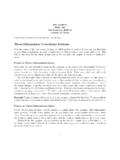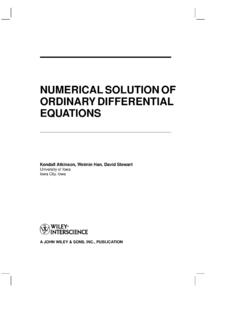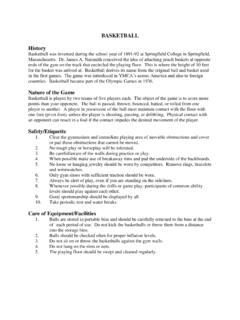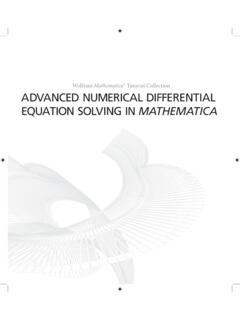Transcription of The Shooting Method for Two-Point Boundary Value …
1 Jim LambersMAT 461/561 Spring Semester 2009-10 Lecture 25 NotesThese notes correspond to Sections and in the Shooting Method for Two-Point Boundary Value ProblemsWe now consider thetwo-point Boundary Value problem(BVP) = ( , , ), < < ,a second-order ODE, withboundary conditions ( ) = , ( ) = .This problem is guaranteed to have a unique solution if the following conditions hold: , , and are continuous on the domain ={( , , ) , < < , < < }. >0 on is bounded on .There are several approaches to solving this type of problem. The first Method that we willexamine is called theshooting Method . It treats the Two-Point Boundary Value problem as aninitialvalue problem(IVP), in which plays the role of the time variable, with being the initial time and being the final time.
2 Specifically, the Shooting Method solves the initial Value problem = ( , , ), < < ,with initial conditions ( ) = , ( ) = ,where must be chosen so that the solution satisfies the remaining Boundary condition, ( ) = .Since , being the first derivative of ( ) at = , is the initial slope of the solution, thisapproach requires selecting the proper slope, or trajectory , so that the solution will hit thetarget of ( ) = at = . This viewpoint indicates how the Shooting Method earned its that since the ODE associated with the IVP is of second-order, it must normally be rewritten1as a system of first-order equations before it can be solved by standard numerical methods such asRunge-Kutta or multistep the case where = ( , , ) is alinearODE, selecting the slope is relatively simple.
3 Let 1( ) be the solution of the IVP = ( , , ), < < , ( ) = , ( ) = 0,and let 2( ) be the solution of the IVP = ( , , ), < < , ( ) = 0, ( ) = can be computed using any analytical or numerical Method . Then, the solution of the originalBVP has the form ( ) = 1( ) + 2( )where is the correct slope, since any linear combination of solutions of the ODE also satisfies theODE, and the initial values are linearly combined in the same manner as the solutions find the proper Value of , we evaluate ( ), which yields ( ) = 1( ) + 2( ) = ,and therefore = ( 1( ))/ 2( ). It follows that as long as 2( ) = 0, then ( ) is the uniquesolution of the original BVP. This condition is guaranteed to be satisfied due to the previouslystated assumptions about ( , , ) that guarantee the existence and uniqueness of the the ODE is nonlinear, however, then satisfies a nonlinear equation of the form ( , ) = 0,where ( , ) is the Value of the solution, at = , of the IVP specified by the Shooting Method , withinitial sope.
4 This nonlinear equation can be solved using an iterative Method such as the bisectionmethod, fixed-point iteration, Newton s Method , or the Secant Method . The only difference is thateach evaluation of the function ( , ), at a new Value of , is relatively expensive, since it requiresthe solution of an IVP over the interval [ , ], for which ( ) = . The Value of that solution at = is taken to be the Value of ( , ).If Newton s Method is used, then an additional complication arises, because it requires thederivative of ( , ), with respect to , during each iteration. This can be computed using the factthat ( , ) = ( , )/ satisfies the ODE = + , < < , ( , ) = 0, ( , ) = 1,which can be obtained by differentiating the original BVP and its Boundary conditions with respectto.
5 Therefore, each iteration of Newton s Method requirestwoIVPs to be solved, but this extraeffort can be offset by the rapid convergence of Newton s that Euler s Method ,y +1=y + f( ,y , ),for the IVPy =f( ,y),y( 0) =y0, is to be used to solve any IVPs arising from the ShootingMethod in conjunction with Newton s Method . Because each IVP, for ( , ) and ( , ), is ofsecond order, we must rewrite each one as a first-order system. We first define 1= , 2= , 1= , 2= .We then have the systems 1 = 2, 2 = ( , 1, 2), 1 = 2, 2 = ( , 1, 2) 1+ ( , 1, 2) 2,with initial conditions 1( ) = , 2( ) = , 1( ) = 0, 2( ) = algorithm then proceeds as follows:Choose (0)Choose such that = , where is the number of stepsfor = 0,1,2,..until convergencedo = 0, 10= , 20= ( ), 10= 0, 20= 1for = 0,1,2.
6 , 1do = + 1 +1= 1 + 2 2 +1= 2 + ( , 1 , 2 ) 1 +1= 1 + 2 2 +1= 2 + [ ( , 1 , 2 ) 1 + ( , 1 , 2 ) 2 ]end ( +1)= ( ) ( 1 )/ 1 endChanging the implementation to use a different IVP solver, such as a Runge-Kutta Method ormultistep Method , in place of Euler s Method only changes the inner












